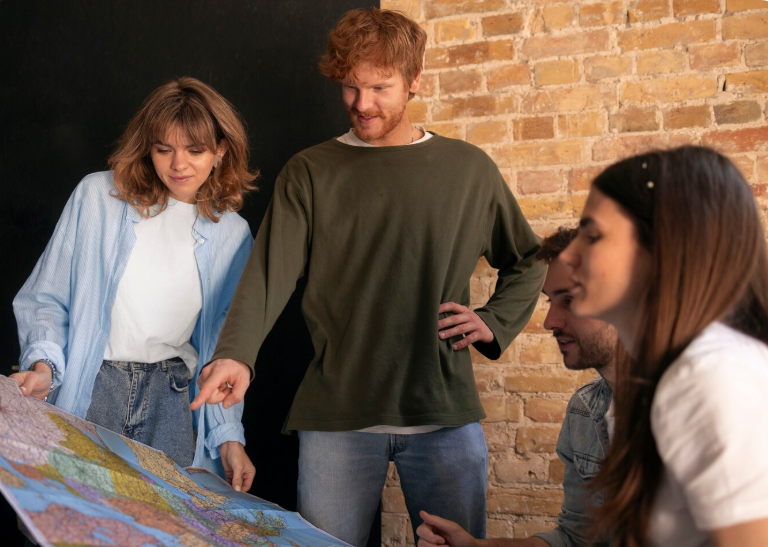
by Dulce Navarro | Jul 7, 2025 | Countries, Culture, Languages, Traditions
The Role of Translation in Preserving Cultural Identity
In a world that is becoming increasingly interconnected, the ability to communicate across borders has never been more vital. Globalization has facilitated unprecedented exchanges of ideas, technologies, and cultures. Yet, in this drive toward a more unified global community, the need to preserve individual cultural identities remains just as critical. Translation plays a fundamental role in striking this balance, serving as both a bridge between communities and a guardian of linguistic and cultural heritage.
Translation as a Cultural Guardian
Translation is far more than a tool for converting words from one language to another. At its core, it is a means of preserving and transmitting culture. Each language carries with it the worldview, values, and history of the people who speak it. When translators work, they aren’t merely exchanging words—they’re conveying context, idioms, humor, customs, and emotional nuance. This ability to carry the spirit of one culture into another without diluting its identity is what makes translation so powerful.
Take literature, for example. Translating a novel isn’t just about telling a story in a different language; it’s about conveying the cultural references, societal norms, and historical context that give that story its depth. Without this, essential meanings and emotional connections can be lost. Through careful, culturally sensitive translation, the voices of minority or endangered communities can be amplified and preserved for future generations.
Historical Importance of Translation in Culture
Historically, translation has served as the backbone for cultural development and intellectual exchange. From the Arabic translations of Greek philosophical texts during the Islamic Golden Age to the Latin translations of Arabic medical literature in medieval Europe, the act of translation has shaped civilizations and passed down critical knowledge.
Religious texts, too, have been translated into hundreds of languages, helping preserve spiritual and ethical systems. In many cases, these translations have sparked cultural renaissances and educational reforms, empowering communities to define their identities through a shared language and heritage.
Localization and Modern Identity
In the digital age, localization—the adaptation of content for a specific region or culture—has become central to the way brands and governments communicate globally. This is more than just adjusting currency or date formats. Effective localization requires a deep understanding of regional values, beliefs, and linguistic subtleties. Done right, it allows communities to engage with global content without losing their cultural lens.
For example, marketing campaigns that succeed in one country may fall flat in another if local cultural values are not considered. Translation helps ensure messages are not only understood but embraced in the local context. It empowers people to engage with international content without having to conform to a foreign framework, thus protecting their cultural perspective.
Translation and Minority Languages
One of the most pressing roles of translation today is in supporting minority and endangered languages. These languages are often at risk of extinction, taking with them unique cultural knowledge, folklore, and traditional practices. Through translation initiatives, oral histories can be documented, and younger generations can reconnect with their roots.
Organizations worldwide are investing in projects that focus on translating content into indigenous and regional languages. This not only fosters inclusion but also strengthens cultural pride and resilience in the face of globalization. Translation becomes a means of activism—preserving identities that would otherwise be forgotten.
The Human Element in Translation
While machine translation has made rapid advances, human translators remain irreplaceable when it comes to cultural preservation. A machine might translate words accurately, but it lacks the emotional intelligence and cultural fluency to interpret tone, humor, or societal nuance. Professional translators carry the responsibility of acting as cultural interpreters, using their deep understanding of both source and target cultures to ensure that meaning—not just language—is preserved.
This is especially important in legal, medical, and literary fields, where mistranslation can lead to misunderstanding, offense, or even harm. In these sensitive contexts, accuracy and cultural awareness are non-negotiable.
Learning New Languages as an Expat: Strategies for Quick Success
Whether you’re an expat navigating a new home or a global executive building international partnerships, learning the local language can greatly enrich your experience. It shows respect for the host culture and enhances your ability to form meaningful relationships and avoid misunderstandings.
Here are some effective strategies to accelerate your language learning journey:
- Engage in Immersion: Surround yourself with the language. Watch local TV shows, listen to music, and try reading the news in your target language.
- Use Language Apps: Leverage tools like Duolingo, Babbel, or Memrise for structured learning on the go.
- Hire a Private Tutor: A tutor can personalize your learning and help you practice business-specific vocabulary relevant to your field.
- Practice Conversationally: Use what you learn in real conversations with locals or through language exchange groups.
- Be Consistent and Patient: Daily practice, even if short, is more effective than occasional long sessions.
Mastering a new language opens doors—not just professionally, but personally. It deepens your connection to your environment, improves cultural sensitivity, and fosters empathy. And most importantly, it helps you thrive, not just survive, in a new cultural setting.
Stay Connected for More Travel and Lifestyle Inspiration
For more insights into travel, culture, and lifestyle tips, follow me on @salvadorordorica. If you’re seeking professional translation and localization services to enhance your global ventures, visit The Spanish Group — your trusted partner in bridging cultures worldwide.

by Dulce Navarro | Jul 2, 2025 | Countries, Culture, Languages, Traditions, Travel
Language Preservation: Why It Matters in a Connected World
In an era where digital communication allows us to connect across continents in seconds, it’s easy to assume that language barriers are dissolving. English, Mandarin, Spanish, and a few other major languages dominate online and business communication. But beneath this globalized surface, thousands of lesser-spoken languages are rapidly disappearing. Language preservation isn’t just about words—it’s about protecting culture, knowledge, and identity. In a connected world, the urgency to preserve linguistic diversity has never been greater.
The Cultural Value of Language
Languages are more than mere tools for communication. They are repositories of a community’s collective memory, values, beliefs, and unique worldview. Each language carries with it idioms, expressions, oral histories, songs, and customs that may not be easily translatable or understandable in another tongue. When a language dies, we lose not just vocabulary, but entire perspectives on life and human experience.
For indigenous and minority communities, language is central to cultural identity. It anchors traditions, preserves ancestral knowledge, and fosters a strong sense of belonging. Preserving a language is, therefore, an act of cultural preservation—one that strengthens social cohesion and intergenerational continuity.
What’s at Risk: The Disappearance of Languages
According to UNESCO, nearly 40% of the world’s 7,000+ languages are endangered. Many of them are spoken by small communities—often in remote or marginalized regions—and are at risk of vanishing within a generation. In some cases, only a handful of elderly speakers remain.
Globalization, urbanization, and the dominance of a few world languages have accelerated this trend. Younger generations are often encouraged to adopt dominant languages for better education and job prospects, while native tongues are neglected or even discouraged in formal settings. Over time, fluency in ancestral languages diminishes until they’re lost entirely.
Why Language Preservation Benefits Everyone
Preserving linguistic diversity isn’t only beneficial for native speakers—it enriches humanity as a whole. Here’s why:
- Scientific and Ecological Knowledge: Many indigenous languages contain unique knowledge of local ecosystems, medicinal plants, and sustainable living practices. Losing the language can mean losing centuries of irreplaceable wisdom.
- Cognitive and Academic Benefits: Multilingual individuals often show enhanced cognitive flexibility, problem-solving skills, and creativity. Learning and preserving diverse languages can thus have educational advantages.
- Social Inclusion: Language rights are human rights. Ensuring that communities can communicate in their native language promotes equality and reduces social marginalization.
- Economic Opportunities: Languages open doors to new markets, tourism opportunities, and cultural exchanges, benefiting both local communities and global partners.
The Role of Technology in Language Preservation
Far from being a threat, digital technology can also be a powerful ally in preserving endangered languages. Mobile apps, digital dictionaries, voice recordings, and AI-powered translation tools are now being used to archive and teach disappearing languages.
Platforms like YouTube and social media provide visibility for minority languages, allowing speakers to create and share content with a global audience. Universities and nonprofits are also partnering with local communities to document and revitalize their native languages through digital storytelling, mobile learning, and cloud-based archives.
The Importance of Translation and Localization
For businesses expanding globally, language preservation intersects with translation and localization. It’s not enough to simply translate words—you need to understand the cultural context behind them. This is where professional translation services become vital.
Organizations like The Spanish Group specialize in accurate, culturally sensitive translations that respect linguistic nuances. Whether adapting marketing campaigns, legal documents, or product instructions, high-quality localization ensures that messages resonate authentically with the target audience while respecting local language and customs.
Supporting such services not only helps businesses succeed internationally but also promotes a more inclusive and linguistically respectful global economy.
How Individuals Can Help Preserve Languages
Language preservation isn’t solely the responsibility of linguists or cultural institutions—anyone can contribute. Here’s how:
- Learn and use minority or indigenous languages, even at a basic level, to keep them alive in daily use.
- Support media, books, music, and content in endangered languages.
- Advocate for multilingual education and linguistic rights in your community or country.
- Partner with translation services that prioritize linguistic diversity and inclusivity.
By valuing linguistic diversity in our personal and professional lives, we foster a world that respects and celebrates human heritage.
Learning New Languages as an Expat: Strategies for Quick Success
Whether you’re moving abroad for work, study, or personal growth, learning the local language is one of the most effective ways to integrate and thrive. Here are a few proven strategies for success:
- Immerse Yourself: Engage with locals, attend community events, and avoid relying solely on English-speaking circles.
- Use Technology: Apps like Duolingo, Babbel, and Memrise make it easy to practice anywhere, anytime.
- Hire a Tutor: A professional language coach can tailor lessons to your needs and correct your mistakes in real-time.
- Practice Daily: Consistency beats intensity. Even 15 minutes a day can lead to measurable improvement over time.
- Watch and Listen: Consuming local media—TV shows, podcasts, and music—helps with listening skills and cultural familiarity.
Embracing the language of your new home not only enriches your experience but also deepens your connection to the community, culture, and daily life.
Stay Connected for More Travel and Lifestyle Inspiration. For more insights into travel, culture, and lifestyle tips, follow me on Instagram
@salvadorordorica. If you’re seeking professional translation and localization services to enhance your global ventures, visit
The Spanish Group — your trusted partner in bridging cultures worldwide.

by Dulce Navarro | Jul 2, 2025 | Consumer, Culture, Europe, Languages, Lifestyle, Travel, Work
How Digital Nomads Navigate Language Barriers
In today’s rapidly evolving digital economy, remote work has become more than just a trend—it’s a lifestyle embraced by thousands of digital nomads around the globe. With the freedom to live and work anywhere, however, comes the challenge of adapting to different cultural and linguistic environments. One of the most common hurdles faced by digital nomads is navigating language barriers, especially when moving frequently between countries with diverse dialects and communication norms.
Understanding the Impact of Language on Daily Life
Language is more than a tool for communication—it shapes how we think, work, and connect with others. For digital nomads, everyday tasks like grocery shopping, navigating public transportation, or even ordering a coffee can become complex in a country where they don’t speak the local language fluently. More significantly, the inability to communicate effectively can isolate individuals, hinder productivity, and affect one’s ability to form meaningful personal and professional relationships abroad.
Language barriers can also impact digital nomads in their work, particularly when collaborating with local clients, attending networking events, or conducting business in international markets. Clear communication is essential for building trust and maintaining professional relationships—something not always possible with a reliance on translation apps or limited vocabulary.
Leveraging Technology for Real-Time Communication
Fortunately, technology plays a crucial role in helping digital nomads overcome these challenges. Translation apps like Google Translate, DeepL, and Microsoft Translator allow travelers to translate signs, menus, and conversations in real-time. Voice-to-text and camera translation features have greatly improved accessibility and convenience, reducing the anxiety of language miscommunication in daily life.
Additionally, browser-based tools like Grammarly and AI writing assistants can help digital nomads write emails, proposals, and social media posts with greater clarity, particularly in multilingual contexts. Communication platforms like Slack or Zoom now also offer real-time captioning and translation features, allowing smoother collaboration across different languages and time zones.
Immersive Experiences and Language Learning
Technology is only part of the equation. Many digital nomads find success through cultural immersion. By intentionally placing themselves in environments where they must speak the local language—whether through volunteering, joining local meetups, or attending workshops—they accelerate their ability to pick up conversational skills. This experiential approach fosters not only language acquisition but also a deeper appreciation for local customs and traditions.
In cities with large expat communities, it’s common to find coworking spaces, cafés, and networking groups where multilingualism is encouraged. These social environments offer a safe and supportive space for practicing a new language, exchanging tips with fellow nomads, and receiving feedback in real-time.
Hiring Local Help and Using Translation Services
Another valuable strategy is hiring professional help. Whether it’s a local guide, a cultural consultant, or a translation service, having experts assist in bridging the communication gap ensures smoother transitions and more effective interactions with local authorities, landlords, or vendors.
For business owners and entrepreneurs, professional translation and localization services like The Spanish Group can be indispensable. They ensure that documents, websites, contracts, and marketing materials are accurately translated and culturally adapted—maintaining brand integrity while respecting local customs.
Creating a Multilingual Routine
Establishing a daily habit of language learning—such as dedicating 15–30 minutes each day to apps like Duolingo, Babbel, or Rosetta Stone—can make a significant difference over time. Even learning a handful of common phrases like greetings, numbers, or basic directions can greatly enhance a nomad’s confidence and reduce daily stress.
Digital flashcards, language podcasts, and YouTube channels designed for language learners also provide effective, on-the-go resources. The key is consistency—small, daily efforts accumulate into long-term fluency, especially when combined with practical use in real-world situations.
Learning New Languages as an Expat: Strategies for Quick Success
For expats and digital nomads alike, mastering a new language quickly requires a blend of strategy, patience, and engagement. Here are a few proven methods:
- Set Realistic Goals: Focus on learning functional vocabulary relevant to your lifestyle and profession.
- Practice Daily: Use language-learning apps, flashcards, or audio lessons consistently each day.
- Engage Locally: Attend events, markets, or clubs where the language is spoken naturally.
- Hire a Tutor: Personalized feedback from a native speaker accelerates fluency and boosts confidence.
- Watch Media in the Target Language: Subtitled TV shows, podcasts, and films enhance comprehension and pronunciation.
By combining these methods, digital nomads and expats can transition smoothly into new environments, deepen their cultural experiences, and communicate more effectively—both personally and professionally.
Stay Connected for More Travel and Lifestyle Inspiration. For more insights into travel, culture, and lifestyle tips, follow me on Instagram
@salvadorordorica. If you’re seeking professional translation and localization services to enhance your global ventures, visit
The Spanish Group — your trusted partner in bridging cultures worldwide.

by Dulce Navarro | Jun 27, 2025 | Business, Company, Countries, Culture, Languages, Lifestyle, Translations, Travel
Translation Services That Elevate Business Travel
In today’s interconnected world, business travel isn’t just about reaching new destinations — it’s about building meaningful, effective relationships across borders. Whether you’re meeting clients in Tokyo, negotiating deals in Paris, or attending a conference in São Paulo, one key factor can make or break your success: communication. And that’s where professional translation services come in.
Bridging Language Gaps with Confidence
Language barriers can hinder productivity, dilute your message, or worse, cause unintended offense. For business travelers, overcoming these hurdles is essential. Translation services ensure that all forms of communication — from documents and presentations to contracts and product descriptions — are culturally accurate, grammatically correct, and professionally localized. This level of clarity can mean the difference between closing a deal and losing an opportunity.
First Impressions Matter
In business, first impressions are everything. When your materials are flawlessly translated into a client’s native language, you immediately demonstrate professionalism, respect, and a genuine interest in local culture. This builds trust and sets a strong foundation for long-term collaboration. It also shows that your brand values inclusivity and internationalism, key traits in today’s global economy.
Supporting Multilingual Meetings and Events
From trade shows to boardroom meetings, having interpreters or translated materials on hand ensures smooth communication. Real-time translation services (simultaneous or consecutive interpreting) allow everyone in the room to follow along, regardless of the language spoken. This not only enhances understanding but also helps participants feel heard and included.
Enhancing International Marketing
Launching a campaign in a foreign market? Localization is critical. This goes beyond mere translation — it involves adapting content to align with the cultural nuances, values, and expectations of your audience. From social media posts and email newsletters to brochures and ad copy, translation services help you speak directly to your customers in a voice they trust and understand.
Complying with Legal and Regulatory Standards
Legal documentation must be meticulously translated to ensure compliance with international laws and local regulations. Whether you’re dealing with immigration paperwork, business contracts, or corporate policies, a professional translation provider ensures your documents meet jurisdictional requirements and maintain legal validity across borders.
Saving Time and Avoiding Costly Mistakes
Using automated tools or relying on bilingual staff may seem like an easy shortcut, but it often leads to misinterpretations and errors. Professional translation services guarantee consistency, accuracy, and speed. With experienced linguists working behind the scenes, your documents will be delivered on time and ready for immediate use — without the risk of misunderstanding or reputational harm.
Tailored Support for Industry-Specific Needs
Different industries require different linguistic expertise. For example, medical translation demands precision and an understanding of clinical terminology, while legal translation must comply with procedural jargon and formatting. Partnering with a translation service that understands your field ensures quality results that align with your industry’s expectations.
Learning New Languages as an Expat: Strategies for Quick Success
While translation services are invaluable, learning the local language as an expat adds another layer of connection and confidence. Here are some quick strategies:
- Immerse Yourself: Surround yourself with the language daily — read signs, watch local media, and listen to conversations.
- Use Language Apps: Duolingo, Babbel, and Memrise make vocabulary building and grammar practice fun and accessible.
- Take a Class: Enroll in a local course to build foundational skills and receive guidance from native speakers.
- Practice Speaking: Engage in language exchanges or conversation meetups. Don’t be afraid to make mistakes — it’s part of the process.
- Label Everything: Tag household items with their foreign language names to reinforce daily vocabulary.
Mastering the language of your host country not only enriches your personal experience but also expands your professional opportunities.
Stay Connected for More Travel and Lifestyle Inspiration. For more insights into travel, culture, and lifestyle tips, follow me on @salvadorordorica. If you’re seeking professional translation and localization services to enhance your global ventures, visit The Spanish Group — your trusted partner in bridging cultures worldwide.

by Dulce Navarro | Jun 25, 2025 | Countries, Culture, Languages, Travel, Worldwide
Language and Identity: How Multilingualism Shapes Worldviews
Language is more than just a communication tool — it is a core component of our identity, a filter through which we understand the world, and a bridge between cultures. In today’s globalized world, multilingualism is not just an asset but a transformative force that shapes how individuals see themselves and others. Whether for personal enrichment, professional advancement, or cultural integration, speaking multiple languages expands the mind and opens doors.
The Cognitive Power of Multilingualism
Research consistently shows that multilingual individuals enjoy enhanced cognitive abilities. From improved memory and problem-solving to greater creativity and multitasking skills, speaking more than one language rewires the brain in powerful ways. Multilingual people are often more adept at switching between tasks and filtering out irrelevant information, making them highly adaptive in fast-paced environments.
Language as a Lens on Culture
Each language carries its own set of values, metaphors, and ways of framing reality. For example, the Japanese concept of “wabi-sabi” — appreciating the beauty in imperfection — is difficult to translate but reflects a distinct worldview embedded in the language. When someone becomes fluent in another language, they don’t just learn new words; they adopt new ways of seeing the world.
Multilingualism and Personal Identity
Multilingual individuals often describe having slightly different personalities in each language they speak. This phenomenon, known as “language-based identity,” illustrates how language influences not only our outward expression but our internal sense of self. A bilingual person might be more assertive when speaking English but more reserved in their native tongue, depending on cultural expectations embedded in the language.
Breaking Down Barriers
Multilingualism breaks down social and professional barriers. In multicultural societies or international business environments, the ability to switch languages fosters trust, collaboration, and mutual respect. It allows for more meaningful interactions and reduces the chance of miscommunication — especially important in diplomatic, legal, or healthcare contexts where nuance matters.
Multilingualism in the Workplace
In business, multilingualism is a clear competitive advantage. Companies with multilingual employees can more effectively navigate foreign markets, communicate with international clients, and localize products and services. It demonstrates cultural sensitivity and global thinking, qualities increasingly valued by employers worldwide.
Preserving Linguistic Diversity
While globalization often leads to language homogenization, multilingualism plays a vital role in preserving cultural diversity. Each language is a repository of history, knowledge, and collective memory. Encouraging language learning and revitalization helps sustain indigenous languages and protects cultural heritage from erosion.
The Emotional Depth of Language
Languages also carry emotional weight. Certain expressions or terms resonate more deeply depending on one’s cultural background and emotional experiences. A phrase like “mi casa es su casa” evokes more than hospitality — it reflects a worldview centered on generosity and community. Multilingual individuals often navigate emotional landscapes that are deeply tied to each of their spoken languages.
Language Learning as a Lifelong Journey
Learning a new language is a lifelong endeavor that goes far beyond grammar and vocabulary. It’s about curiosity, connection, and continuous growth. As people evolve, so too does their relationship with the languages they speak. Each stage of fluency brings new insights, relationships, and self-awareness.
Learning New Languages as an Expat: Strategies for Quick Success
For expats living abroad, language acquisition is often both a necessity and a gateway to belonging. Here are a few practical strategies to accelerate language learning:
- Immerse Yourself: Speak, listen, and think in the new language as much as possible. Change your phone settings, watch local news, and listen to local music.
- Take Advantage of Language Exchanges: Meet locals through language exchange apps or in-person meetups. It’s a fun, practical way to improve conversational skills.
- Practice Daily: Consistency beats intensity. Even 15 minutes a day of focused study can lead to steady improvement.
- Be Patient and Positive: Mistakes are part of the process. Embrace them, and don’t let perfectionism slow your progress.
Ultimately, learning a new language as an expat deepens your integration into the community, enhances your cultural experience, and helps build lasting relationships.
Stay Connected for More Travel and Lifestyle Inspiration.
For more insights into travel, culture, and lifestyle tips, follow me on @salvadorordorica. If you’re seeking professional translation and localization services to enhance your global ventures, visit The Spanish Group — your trusted partner in bridging cultures worldwide.

by Dulce Navarro | Jun 17, 2025 | Countries, Culture, Languages, Traditions, Worldwide
Preserving Endangered Languages Through Digital Media
Languages are far more than just tools for communication—they are living repositories of culture, identity, history, and worldview. Unfortunately, in our rapidly globalizing world, thousands of languages are at risk of extinction. According to UNESCO, nearly 40% of the world’s 7,000 languages are endangered, with one language vanishing every two weeks. But there is hope. Digital media has emerged as a powerful force in preserving and revitalizing these invaluable linguistic treasures.
The Role of Digital Media in Language Preservation
Digital technology has revolutionized the way we interact with language. From mobile apps and podcasts to online dictionaries and video platforms, digital tools offer accessible and engaging ways to document, learn, and share endangered languages.
One key benefit of digital media is scalability. A well-designed app or website can reach a global audience instantly, allowing indigenous communities and linguists to collaborate across continents. Moreover, these platforms provide younger generations with interactive and modern formats that encourage engagement with their native tongues—bridging the gap between tradition and technology.
Examples of Digital Language Preservation in Action
Numerous organizations and grassroots initiatives are using digital media to keep endangered languages alive. For example:
- Wikitongues: This nonprofit collects and shares videos of native speakers from around the world, providing valuable linguistic data and raising awareness about language diversity.
- FirstVoices: An initiative developed by the First Peoples’ Cultural Council of Canada, offering digital archives, keyboard apps, and educational games for over 75 Indigenous languages.
- Google’s Endangered Languages Project: A collaborative platform connecting linguists and speakers to archive and promote lesser-known languages through videos, documentation, and community support.
Community Engagement is Key
Technology alone cannot save a language. Active community involvement is essential. Elders, native speakers, educators, and youth must work together to create, consume, and share content in their endangered languages. By digitizing oral histories, songs, poems, and everyday conversations, communities can preserve linguistic nuances that textbooks often overlook.
Social media also plays a critical role. Platforms like Instagram, YouTube, and TikTok are being used creatively to share language tutorials, storytelling, and cultural content. These digital spaces not only promote visibility but also foster a sense of pride and identity among younger speakers.
Challenges and Ethical Considerations
Despite its potential, digital preservation faces several hurdles. Not all communities have reliable access to the internet or the technological infrastructure needed to create high-quality digital content. Funding can also be a significant barrier, particularly for remote or marginalized groups.
Ethically, it is important to ensure that language documentation respects cultural boundaries and involves the community in decision-making. Intellectual property, representation, and consent must be prioritized to avoid exploitation or misrepresentation of cultural heritage.
The Business Case for Multilingualism
From a business perspective, supporting linguistic diversity is not just a cultural initiative—it’s a strategic advantage. Companies that embrace multilingualism can reach broader markets, foster inclusivity, and enhance brand reputation. Digital language preservation projects, particularly those that include high-quality translations and localization, align with the values of diversity, equity, and inclusion (DEI), which are increasingly important to consumers and stakeholders alike.
Brands that invest in content tailored for specific linguistic communities—whether endangered or widely spoken—demonstrate a genuine commitment to cultural preservation. It’s a win-win: expanding reach while contributing to a global cause.
Learning New Languages as an Expat: Strategies for Quick Success
While preserving endangered languages is vital, learning new languages is equally important for today’s global citizens—especially expats. Immersing yourself in a new language can enrich your personal and professional life, help you integrate into your community, and unlock doors to new opportunities.
Here are a few quick strategies for success:
- Practice Daily: Dedicate 15–30 minutes a day to active practice—use language apps, flashcards, or journaling.
- Immerse Yourself: Watch local TV, listen to music, and follow social media accounts in your target language.
- Speak From Day One: Don’t wait until you feel “ready.” Start speaking early and often, even if it’s just basic phrases.
- Find a Language Partner: Language exchanges with locals or fellow learners can keep you motivated and correct your mistakes in real-time.
- Use Local Resources: Attend local classes or cultural events where you can meet native speakers and build real-world connections.
Mastering a new language as an expat takes time, but the rewards—both personal and professional—are well worth the effort. Not only do you gain a deeper understanding of your host culture, but you also build bridges between communities, much like the digital tools working to preserve endangered languages.
Stay Connected for More Travel and Lifestyle Inspiration.
For more insights into travel, culture, and lifestyle tips, follow me on @salvadorordorica.
If you’re seeking professional translation and localization services to enhance your global ventures, visit The Spanish Group — your trusted partner in bridging cultures worldwide.






